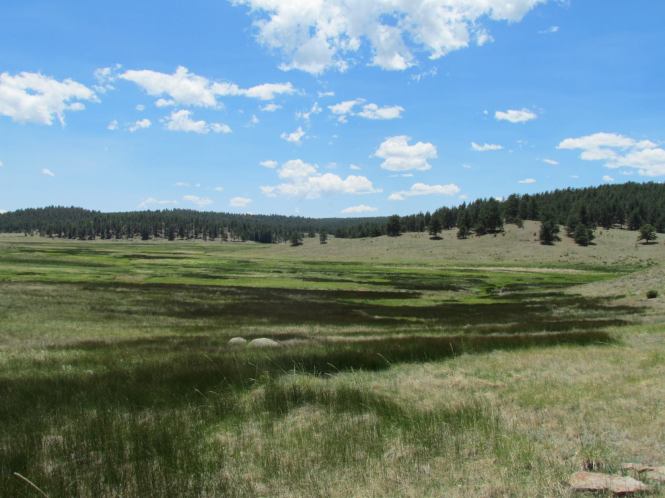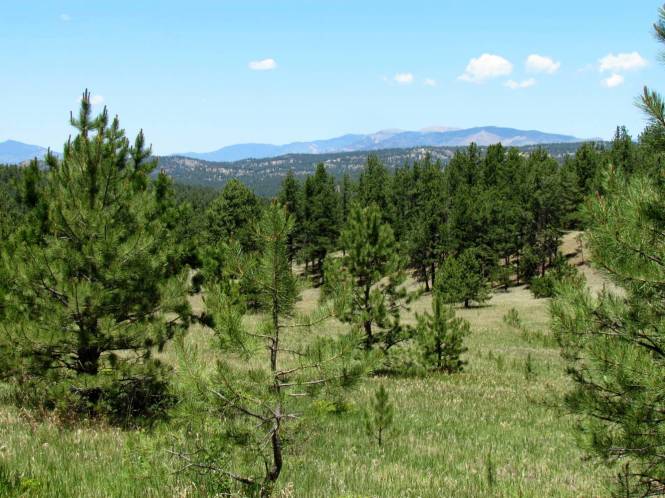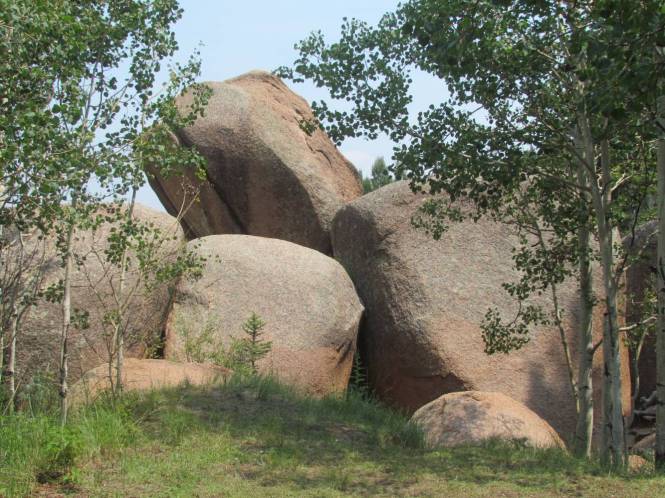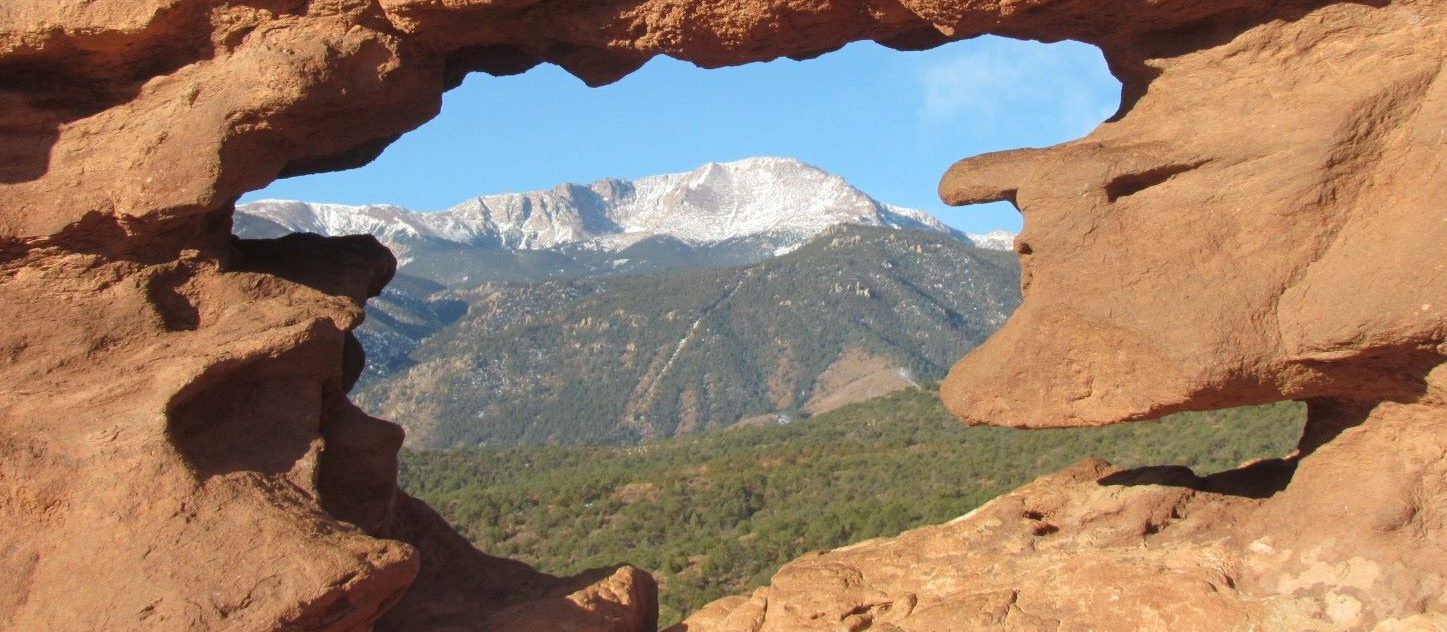Today, I would like to take you back to Florissant Fossil Beds National Monument. If you didn’t travel there with me last week, please do so here for background and context.
After parking and checking in at the front desk, you can watch the documentary about the history of this place and/or read about it in the museum, or skip those steps and simply move on from the Visitor Center. Just behind it, the fossilized “Redwood Trio,” protected by a canopy, captures one’s gaze and imagination. To the right stretches the Florissant Valley at an elevation of approximately 8,500 feet (ca. 2,600 meters), with the Hornbek Homestead visible along its northern boundary. To the left and ahead lie several trailheads in dense stands of Ponderosa Pines. A modern tree growing out of a fossilized one nearby is the perfect metaphor for this special site: We present-day dwellers stand on the shoulders of everything that preceded us, and with every step we take, the earth’s past holds us up.
The National Monument offers glimpses not only into our geologic past but also into our present-day environment: 14 miles of trails afford the opportunity to explore today’s ecosystems. They can be accessed from three parking lots: the main one at the Visitor Center, a second at the Hornbek Homestead, and a third at the Barksdale Picnic Area, located on the eastern edge of the monument. From the 0.4 mile, wheelchair-accessible Ponderosa Loop or the 0.6 mile Geologic Trail, to several loops that measure between 3 and 4 miles and can be combined into longer circuits, the visitor can choose different distances and destinations. At times the trail winds through the forest made up of mostly Ponderosa Pines with interspersed Douglas Fir and Quaking Aspen, at others it undulates through wide-open meadows or wetlands. For a map and listing of the different trails, click here for a link to the National Park Service’s excellent map.

Fossilized Redwood Trio

View of Florissant Valley from one of the hiking trails

View from one of the hiking trails

Cluster of granite boulders along the Boulder Creek Trail, our favorite picnic spot
Wildflowers enliven the scenery during spring, summer, and fall, and one might espy deer and various species of ground and tree squirrels. A birder’s heart is gladdened by feathered beings in all seasons.
To enlarge a photo, click on it. To read its caption, hover cursor over it.
Azure-colored bluebirds float through open spaces near trees, raptors soar overhead, and one avian species lives among the ubiquitous pines: Williamson’s Sapsuckers. Their scientific name, Sphyrapicus thyroideus, is derived from Greek, with sphura meaning “hammer,” pikos meaning “woodpecker,” and thyroideus meaning “shield-like,” possibly referring to the black breast patch on the female.
To enlarge a photo, click on it. To read its caption, hover cursor over it.
According to Cornell’s All About Birds,
The male Williamson’s Sapsucker is a silken black woodpecker with a cherry-red throat, a rich yellow belly, and sharp white wing patches. Unlike most woodpecker species, the female looks totally different . . . almost like a diminutive flicker, with a mousy brown head, banded back, and small patches of black and yellow on the belly. This fairly common sapsucker of western mountains drills rings of holes in coniferous trees, then feeds on the tree’s sap.
About the bird’s common name, Williamson’s Sapsucker, Cornell has this to say:
Williamson was an ambitious, no-nonsense engineer rather than a naturalist. After graduating from West Point . . . , Williamson joined the Army as a topographical engineer and spearheaded expeditions into the Pacific wilderness to plan America’s first transcontinental railroad.
Williamson’s party was surveying in 1855, near Klamath Lake, Oregon, when the expedition’s naturalist, John Newberry, spied a striking black, white, and yellow woodpecker that was like nothing he’d seen before. As was customary for the time, he shot the specimen, described it as a new species, and named it for his boss: Picus williamsonii, Williamson’s Sapsucker.
In 1870, Spencer Fullerton Baird (of Baird’s Sparrow and Baird’s Sandpiper) called Newberry’s specimen “so entirely different from any other American bird as to require no special comparison.” It turns out special comparison is exactly what this bird required: the species had already been described just four years earlier—from that uniquely feathered female. For nearly 20 years, the two sexes remained “different” species, at least officially.
In 1873 a naturalist in Colorado [Henry Henshaw] discovered a male and female nesting together and finally put the issue to rest. The species was renamed Sphyrapicus thyroideus, in deference to the original description of the female, but kept Williamson as the bird’s common name.
Whether you come to Florissant because you love fossils of plant or animals, or their living descendants, time spent here is time well-spent.
🌎🌎🌎🌎🌎🌎🌎🌎🌎🌎🌎🌎🌎
As an aside, in November 2023, the American Ornithological Society announced that it would rename all birds with eponymous names—i.e. species named for a person, in order to make a name more descriptive. Not surprisingly, this decision has created controversy. More often than not, as in Williamson’s case, the person for whom a species was named had nothing to do with the bird in question, and many people also take issue with the possessive case that makes it sound as though a bird belonged to someone. I am curious to learn your opinion about the matter, if you would like to share it!












I have read before that your AOS was changing the names, mostly because the person who’s name is used had a dark past. Well my personal opinion is that it is ‘political correctness’ gone mad. Some people do not seem to have anything better to do than meddle and change because things do not align with their personal views. Well ok perhaps some of these historical figures were a bit dodgy, so what, that’s the past.
No doubt were the AOS leads the BOU might follow. The good news is I’m getting too old to take any notice. a Pallas’s Warbler will always be a Pallas’s Warbler.
LikeLiked by 3 people
Thank you for your comment. The renaming question brings up all kinds of reactions. The best essay I have read in response to the suggestion was written by eminent bird expert and field guide author, Kenn Kaufman. Here is a link, in case you are interested: http://www.kaufmanfieldguides.com/kenn-on-the-issues
LikeLike
Fantastic place. Interesting read and awesome photos, Tanja.
LikeLiked by 2 people
Thank you, Michael. Your visit and comment are much appreciated.
Tanja
LikeLiked by 2 people
You’ re most welcome, Tanja.
LikeLiked by 1 person
Morning, Tanja. This is an area I’d love to wander through. Those trees! Had you ever seen the Williamson Sapsucker before?
LikeLiked by 2 people
It’s a wonderful place for a wanderer, Neil. I have seen the sapsuckers many times and I always enjoy watching them, especially when they lick sap or visit nest to feed their young. In the latter case, one can hear some loud begging noises emerge from the nest in a tree cavity. 🙂
LikeLiked by 1 person
With regard to “a modern tree growing out of a fossilized one,” can you clarify what “growing out of” means? Has the living tree taken root in a crack in the fossilized tree, just as it might in a sidewalk crack or a fissure in a cliff?
The question of whether to rename eponymous bird species strikes me as pretty arcane. I’d be happy if more American adults could show they’ve mastered elementary school English and know the difference between the possessive case singular and the nominative or objective case plural—that is to say, if people would stop writing things like “My family has three car’s.”
LikeLiked by 2 people
Yes, that’s exactly what I meant with my remark about the tree. I could have explained it better.
I understand your frustration about people’s troubles with proper grammar and spelling. It seems most pronounced in our mother tongue. I only began to understand German grammar once I started to study a foreign language.
LikeLike
Agreed: studying a foreign language is an excellent way to get insights into one’s own language.
LikeLiked by 1 person
I really enjoyed visiting the Florissant Fossil Beds and trails, through your photos, Tanja. The tree growing out of a fossilized one must have been quite a sight to behold! I had never heard of a woodpecker who feeds on sap before, just thought they were all drilling for insects, so this was quite surprising to hear as well.
LikeLiked by 2 people
I’m glad you went along on and enjoyed this visit, Julie. It’s a favorite destination for us. And seeing wildlife and birds is always a bonus. There are several kinds of sapsuckers in the Americas, all of whom feed on sap. It’s so interesting to watch them do that. I’m sure you have some species of sapsucker where you live.
LikeLiked by 1 person
Ancient geological history, massive boulders, wildflowers, wildlife, your poost has it all., Tanja. The park is a great place to visit.
LikeLiked by 2 people
You summarized it perfectly, Peter. Thank you!
LikeLiked by 1 person
https://www.nzz.ch/panorama/dutzende-von-voegeln-in-nordamerika-werden-umbenannt-ld.1763707
Was es alles gibt, Tanja.
Noch nichts davon gehört bisher.
Danke für den Hinweis.
Was ich davon halten soll weiß ich noch nicht.
Da muss ich drüber nachdenken.
Das von dir besuchte Areal ist wunderschön.
Liebe Grüße Brigitte
LikeLiked by 2 people
Danke für den Kommentar und den Link, liebe Brigitte. Wie Du Dir vorstellen kannst, haben viele eine feste Meinung was die Umbennung der Vögel angeht. Es ist keine leichte Entscheidung. Wenn Du Lust hast, eine Meinung eines amerikanischen Vogelexperten zu lesen, den ich sehr respektiere, hier gibt es einen Link: http://www.kaufmanfieldguides.com/kenn-on-the-issues
Euch Bremern wünsche ich eine gute Woche.
Tanja
LikeLiked by 1 person
I love your metaphor about standing on the shoulders of the past. A very apt description for Florissant.
As for the bird renaming, it sounds like a recipe for lots of confusion. While I’m not against renaming things in some situations (for example, Mount Blue Sky), it seems unnecessary if the reason is simply “to make them more descriptive.” One could easily just look up a photo of the bird by its current name to see what it looks like. Also, then you’ll end up with birds that look very similar and now have very similar names, which to me seems even more confusing.
LikeLiked by 1 person
Thank you, Diana.
The renaming question brings up all kinds of reactions. The best essay I have read in response to the suggestion was written by eminent bird expert and field guide author, Kenn Kaufman. Here is a link, in case you are interested: http://www.kaufmanfieldguides.com/kenn-on-the-issues
LikeLiked by 1 person
Thanks for sharing. That perspective does make sense.
LikeLiked by 1 person
The fertile earth is being well used by the forest and flowers. The tree growing out of the fossilized one is amazing.
I agree with Diana, renaming the birds will likely add to more confusion.
Maggie
LikeLiked by 2 people
Thank you, Maggie. It’s a place filled with many wonders.
The renaming question brings up all kinds of reactions. The best essay I have read in response to the the suggestion was written by eminent bird expert and field guide author, Kenn Kaufman. Here is a link, in case you are interested: http://www.kaufmanfieldguides.com/kenn-on-the-issues
LikeLiked by 1 person
I wonder what Robin will be called in the future…
LikeLiked by 1 person
I don’t think there are any plans to rename robins. Only birds named for people!
LikeLiked by 1 person
Oh I guess I assumed it was 😊
LikeLiked by 1 person
That’s a good point, Maggie. American Robins were named because Americans thought they resembled European Robins, which they don’t, at least not when one looks closely. I always assumed that robin referred to the red breast, but I found this interesting article that explains its possible connection to the name Robert: https://www.birdspot.co.uk/bird-brain/how-did-the-robin-redbreast-get-its-name
However, the bird isn’t named for anyone in particular, unlike Williamson’s Sapsucker, or Wilson’s Warbler. The latter two are examples of the kinds of names targeted for renaming.
LikeLike
Didn’t mean to send you down the research rabbit hole😊. I knew the NA robin was named after the UKs but had assumed there was an original person that it was named for. But I didn’t know there were so many other ‘robin’ birds. Thanks Tanja!!
LikeLiked by 1 person
I love rabbit holes! 🙂
LikeLiked by 1 person
Beautiful! Love your description, especially since we want to visit someday.
LikeLiked by 1 person
Thank you, Pam, I’m glad you enjoyed the post and I hope you will be able to visit sometime.
LikeLike
Thanks for the pictures, Tanja.
LikeLiked by 1 person
Thanks for visiting and commenting, Pit.
LikeLike
Very interesting blog entry! Thank you!
LikeLiked by 1 person
Thank you, Christa. I’m glad you think so.
LikeLiked by 1 person
Great set of photos and what an interesting place to visit! I’ve not heard of a Williamson’s Sapsucker; so great that you got both an adult and juvenile.
Seems like lots of folks have their knickers in knots over the proposed name changes. I dunno, this happens in science all the time. Ever notice how often botanists change plants’ names or their family connections? Yes, it’s hard to have to learn new stuff…but gee, I like the idea of naming a bird by some physical attribute, or where it breeds, or some other descriptor of the bird’s life, rather than after a human who might have had no connection to the animal. But that’s just me. I’ll probably still call a Cooper’s Hawk a Cooper’s Hawk. 🙂
LikeLiked by 1 person
Thank you, Tina. There is a chance to see this sapsucker in TX, or in NM, the next time you visit (see range map https://www.allaboutbirds.org/guide/Williamsons_Sapsucker/maps-range)
You make a great point about plants being renamed all the time. I think the backlash about the proposal to rename birds is a result of the deep divisions in the country as well as some people’s unwillingness to even consider to look at this country’s history in a critical way.
The best response to the suggestion I have read was written by eminent bird expert and field guide author, Kenn Kaufman. Here is a link, in case you are interested: http://www.kaufmanfieldguides.com/kenn-on-the-issues
LikeLike
What a gorgeous location to visit – for any reason! Thank you for introducing it to us.
Common names for species begets confusion, frustration and potential for errors. In my not very humble old person’s opinion – scientific nomenclature should be drummed into our heads before we leave the crib.
Calling a bird by a common name, “look at that quail”, can be handy when you’re with someone who knows it’s a Bob White. But for recording purposes, eliminate confusion by learning scientific names.
Again, pardon my old age showing once more, but don’t believe the nonsense that some organization such as the AOS wants to change some names “… in order to make a name more descriptive… “. Socially “woke” narrative engineers are hard at work in all aspects of our lives.
Gotta go. I hear a Buteo lineatus calling for me to come out and play.
LikeLiked by 1 person
Thank you for your interest and comment, Wally.
If all of us had a solid understanding of Greek and Latin, we might not have such a hard time with scientific names. I doubt we will back to teaching the Classics to kids, even though I think it would be a great idea.
The renaming question is complex and brings up all kinds of reactions, as you know. The best essay I have read in response to the suggestion was written by eminent bird expert and field guide author, Kenn Kaufman, whom you know of, without a doubt. Here is a link, in case you are interested:
http://www.kaufmanfieldguides.com/kenn-on-the-issues
LikeLike
A bird by any other name would sound as sweet (with my apologies to Shakespeare) 😉
LikeLiked by 1 person
Thank you, Eliza. I’m sure Shakespeare would love to have you (mis)quote him. 😊
LikeLiked by 1 person
I like the non-fossilized subjects as much as the fossilized ones.
LikeLiked by 1 person
Thank you, Brad. I feel the same way.
LikeLiked by 1 person
Und die Bilder der Vögel sind grandios. ich habe stundenlang Vögel beobachtet und versucht zu fotografieren auf verschiedenen Birding Trails in Texas. Deine Bilder zeigen mir wieder einmal, wie wunderbar die Vogelarten in den Staaten sind, wie groß die Artenvielfalt. Paßt gut darauf aus. LG Maren
LikeLiked by 1 person
Danke, liebe Maren, es freut mich, daß Dich die amerikanischen Vögel ebenso begeistern wie mich. Die europäischen sind aber auch wunderbar, was mir jedes Mal auffällt, wenn ich wieder in Deutschland bin. Vielleicht begeistern wir uns etwas mehr für die Arten, die uns nicht ständig umgeben. Aber wunderbar sind sie alle. 😊🐦🦅🦆
LikeLiked by 1 person
To change bird’s names to that of a person is ridiculous to the extreme in my opinion. Unless you’re an avid ornithologist with a photographic memory, how on earth are you meant to identify birds, especially when travelling to other states or countries, borders on the impossible.
Common blackbird, Crested pigeon, Red-browed finches and Superb fairy-wrens in my area on the western side of Melbourne, Australia, seem to be sensible and easy to remember, but Williamson’s Sapsucker?
This is really taking nomenclature too far.
It’s more important to save our avian friends and their habitat than waste time re-naming. Obviously, the renaming folk are bored and got nothing better to do with their time.
LikeLiked by 1 person
Thank you for sharing your thoughts, Vicki. I don’t know if you misunderstood my words or I misunderstood your comment, but the idea is to rename birds who are now named for people in order to give them names that are more descriptive, liked the ones you mentioned.
This has caused a lot of controversy because some people don’t want what they consider an “erasure of history,” because the birds are named for people in the past. This is an extension of the political divide that, unfortunately, is so rampant in this country.
The best essay I have read in response to the suggestion was written by eminent bird expert and field guide author, Kenn Kaufman. Here is a link, in case you are interested: http://www.kaufmanfieldguides.com/kenn-on-the-issues
LikeLike
I recently bumped into the name-changing business when I learned that the bird I learned to know as the Moorhen, or Common Moorhen, now has been re-named the Common Gallinule. According to an in-the-know blogger, “The problem was that the Old World birds have been “Moorhens” forever, but culturally sensitive naming committee was not comfortable using the word “Moor”, which referred in history to the Moorish people, who have very dark skin.”
In fact, the bird wasn’t named for Moors-the-people, but for moors-the-marshy-places where the birds lived in the old world. The name change is one more example of the triumph of contemporary ideology over history and common sense.
LikeLiked by 1 person
Thank you for your comment, Linda.
The renaming question brings up all kinds of reactions. The best response I have read to the suggestion was written by eminent bird expert and field guide author, Kenn Kaufman. Here is a link, in case you are interested: http://www.kaufmanfieldguides.com/kenn-on-the-issues
LikeLiked by 1 person
Thanks again, Tanja for showing us around this place which is interesting on so many levels. Personally, I’m not sure I do like the idea of naming a bird after a person. After all, the bird species was there long before the person. It has me wondering, as well, how some of the birds familiar to me got their names. Blackbird is an obvious one, but Robin? Chiff-chaff? Sparrow?
LikeLiked by 1 person
Thank you for your comment, Michael. This renaming topic has people up in arms, which is very unfortunate. It think it raises some important questions, but it might not be the best time to try to find answers to them, considering the deep divisions in this country and all the challenges birds face.
LikeLiked by 1 person
Fascinating. Naming birds after the person for whom it was shot sounds very ill advised to say the least!
LikeLiked by 1 person
Thank you for your comment, Cathy. The renaming question brings up all kinds of reactions. The best essay I have read in response to the suggestion was written by eminent bird expert and field guide author, Kenn Kaufman. Here is a link, in case you are interested: http://www.kaufmanfieldguides.com/kenn-on-the-issues
LikeLike
Thank you for this tour around the Florissant Fossil Beds National Monument. I’m sad that we never found it during our travels in your part of the US.
I followed up on your recommendation to other commentators, and read Kaufman’s essay on the renaming of birds with interest. I agree with his observation that “learning is easier if you avoid the needless distraction of eponymous bird names.” In an ideal world the naming of birds (or other living creatures) would never have taken this path. But we are where we are, and I do worry that the debate is a distraction from the most important task facing birders everywhere, which is to ensure that future generations still have birds to watch.
Yes, we can change eponymous names to others that are more descriptive, and while we do so confusion will reign and birds will continue to die. We need to inspire and motivate people, particularly the younger generation, to care enough about birds to protect them and their habitats from the perils that our own species inflicts. Erudite, intellectual navel gazing about the correct way to name a bird will do nothing to prevent that bird going extinct. In my humble opinion our priority should be the saving of birds, not the naming of birds.
LikeLike
Thank you so much for your thoughtful comment, Mr. P. I apologize for the late reply but your comment ended up in my spam folder. I’m glad I checked it!
I agree with your assessment of the situation. I think the timing of this debate could not be worse and that there are other, far more pressing concerns regarding birds. And the topic will only deepen already-existing divides when all bird lovers should stand united in trying to protect our favorite creatures.
LikeLiked by 1 person
No worries, I had a similar issue myself a few months ago: comments from several regular contributors to my blog – but not yours – washed up in my spam folder one day for no obvious reason. I now make a point of checking that folder most days, just in case. WordPress moves in mysterious ways!
Regarding the subject matter, we are – as so often! – of a similar mind. Conservation should be the top priority of anyone who cares about the natural world.
LikeLike